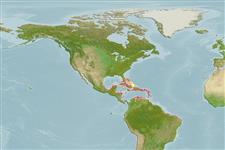Bivalvia |
Lucinida |
Lucinidae
Environment: milieu / climate zone / गहराई सीमा / distribution range
पारिस्थितिकी
; खारा; गहराई सीमा 0 - 2 m (संदर्भ 87155). Subtropical; 27°C - 28°C (संदर्भ 87155); 36°N - 29°S, 98°W - 34°W
Western Atlantic: Canada to North Carolina, Florida, Texas, West Indies, Venezuela, Suriname, Brazil (Amapa to Santa Catarina).
Length at first maturity / आकार / Weight / Age
परिपक्व अवधि: Lm 3.0 range ? - ? cm
Depth range from Belize (Ref. 87155). Minimum depth based on its ecology (Ref.104470). Typically found in calm waters (Ref. 105409). Dominates confined areas of mangrove swamps. Lives deeply burrowed in reducing mud (Ref. 104215). Also in sandy-muddy sediments burrowing from 10 to 20 cm (Ref. 104470). Strictly filter-feeder (Ref. 104242), specifically a suspension feeder (Ref. 105409). In general, suspension feeding bivalves mainly depend on phytoplankton and detritus material for nutrition (Ref. 107088).
Life cycle and mating behavior
परिपक्व अवधि | पुनरुत्पत्ति | मछलीऔ का अंडे देना | Eggs | Fecundity | Larvae
Life cycle: Embryos develop into free-swimming trocophore larvae, succeeded by the bivalve veliger, resembling a miniature clam (Ref. 833).
Turgeon, D.D., J.F. Quinn Jr., A.E. Bogan, E.V. Coan, F.G. Hochberg, W.G. Lyons, P.M. Mikkelsen, R.J. Neves, C.F.E. Roper, G. Rosenberg, B. Roth, A. Scheltema, F.G. Thompson, M. Vecchione and J.D. Willams 1998 Common and scientific names of aquatic invertebrates from the United States and Canada: Mollusks, 2nd ed. American Fisheries Society (Special publication 26), Bethesda, Maryland. 526 p. (संदर्भ 1667)
IUCN Red List Status
(संदर्भ 130435: Version 2025-1)
CITES status (संदर्भ 108899)
Not Evaluated
CMS (संदर्भ 116361)
Not Evaluated
Threat to humans
Human uses
मात्स्यिकी: व्यापारिक
| FishSource |
साधन
अधिक जानकारी
Population dynamicsबाढ़Max. ages / sizesLength-weight rel.Length-length rel.Length-frequenciesMass conversionबहुतायत PhysiologyOxygen consumption
Human RelatedStamps, coins, misc.
इंटरनेट स्रोत
Estimates based on models
Preferred temperature
(Ref.
115969): 26.5 - 28.3, mean 27.4 (based on 306 cells).
Price category
Unknown.
